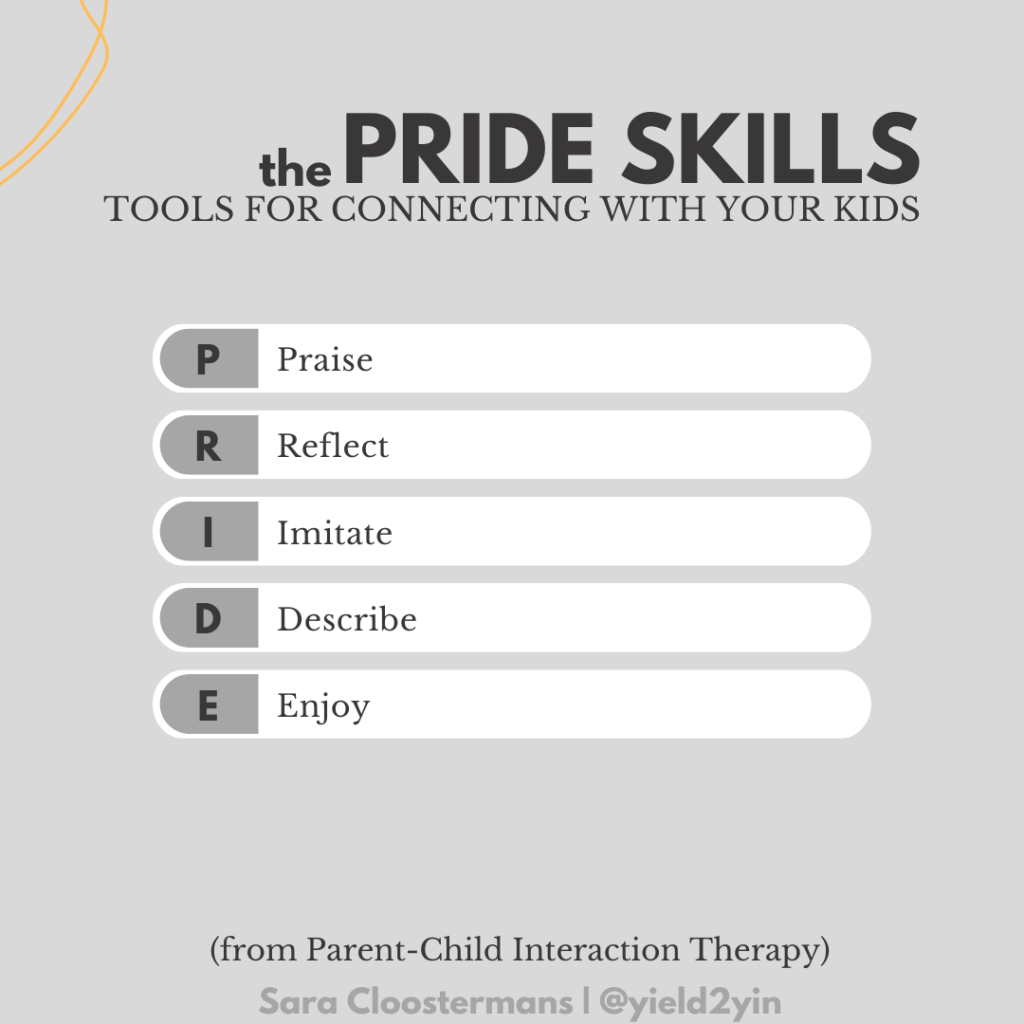Last week, we discussed Parent-Child Interaction Therapy (PCIT), a type of therapy that can help strengthen the bond between parent and child. Though originally created to use in a therapy setting with parents and their children with severe behavior problems or trauma, many of the skills taught in PCIT are incredibly helpful for any parent of any child.
Let’s start with the PCIT “PRIDE skills.”

In the first phase of PCIT, the child directs the play. The parent follows their child’s lead and along the way uses “PRIDE skills,” a series of positive parenting techniques that make the child feel seen, heard, accepted, and valued.
The acronym PRIDE stands for:
- Praise
- Reflect
- Imitate
- Describe
- Enjoy
Let’s take a closer look at how to implement these simple skills and at the goals behind them.
1. PRAISE

When you praise your child, you show approval of something they are doing or saying. There are two types of praises: unlabeled and labeled. Unlabeled praises are general, and labeled praises (preferred) are specific praises.
Examples of unlabeled praises:
- Thank you!
- Great work!
- Nice job!
Examples of labeled praises:
- Thank you for setting the table.
- Great work making your bed.
- Nice job helping your sister with her math homework.
It is especially helpful to use labeled praises when you catch your child doing the opposite of their problem behaviors. For example, if your child has a problem with hitting his younger sibling, then make sure you praise them every time you see them “using gentle hands”:
“Thank you for using your gentle hands when you were playing legos with your little brother.”
It is likely this technique will decrease the problem behavior, and hopefully eliminate it altogether, while increasing the desired behavior. Your child will like how people’s responses to their behavioral changes make them feel.
Labeled praises increase children’s self-esteem and desired behaviors.
2. REFLECT

A reflection is when the parent paraphrases what the child shares with them. Depending on your child’s language development, you give them the words entirely, you give them the words correctly, or you switch up the words, so it is less noticeable that you are simply repeating what they are sharing with you.
Examples:
- An example of giving your child the words entirely is when your 12-month-old points to their bottle of milk, and you reflect back: “You want your milk; you are thirsty!”
- An example of giving a child the words correctly is when a 2-year-old says, as he is playing with his blue car “I pay geen (incorrect color) ca”, and you reflect back: “You are playing with your blue car.” ***Note: there is no need to add “That is not green, that is blue.”
- An example of switching up the words is when your 5-year-old says “Bennie was mean to me; he hit me in the playground because I beat him to the slide.” You reflect back: “It sounds like Bennie played roughly with you during recess today just because you made it to the slide faster than he did.”
Reflections teach babies and toddlers how to talk. Reflections also serve as validations and remind your child that not only do they have a voice, but also that what they have to say is important to you and valid; they make your child feel heard and seen. Reflections also encourage your child to keep talking, if they feel like it … giving them an opportunity to go deeper.
3. IMITATE

With this skill, a parent imitates their child’s positive behaviors in order to show approval of the child’s play and make them feel important. This skill only applies when the child is playing nicely and exhibiting appropriate behaviors.
Example: Let’s say that the child is starting to build a structure with bristle blocks, the parent might say: “I see that you are building a barn for your farm animals. I am going to build a barn too.” The parent then starts building a barn of their own.
Imitation increases cooperation and positive behavior.
4. DESCRIBE

When giving behavioral descriptions, the parent points out positive behaviors. Think of behavioral descriptions as a sports announcer narrating a football game. You basically tell your child and whoever else is present (spectators) what you saw your child do or say that was positive.
I like this skill a lot because it is a great way to make a child feel important without giving them praise every time.
Examples:
- I saw you watering the plants; they really needed it and look so much greener and healthier already.
- I saw you sharing your toys with our little neighbor, Charlie; I noticed Charlie felt included and really enjoyed playing with you.
Behavioral descriptions increase children’s self-awareness and other-awareness.
5. ENJOY

The parent shows, through either verbal or non-verbal communication, that they are having an enjoyable time playing with their child.
Example: “I’m having fun playing with you; you have such great ideas!” (verbal) or the parent rubs their child’s back while they are building a barn with their blocks (non-verbal).
This can be a big ask from a parent who is dealing with a mood and/or anxiety disorder because showing joy for someone who feels severely depressed or highly anxious is not easy. However, the goal is for the parent to act in “congruence” with the circumstances when parenting – in this case, having their response to their child be congruent with the child’s positive behavior even if this means for the parent to “fake it till you make it.”
As you can imagine, “incongruent” communication is incredibly confusing to a child. Here is an example of incongruence: a parent and child are playing together, the child is playing nicely and having fun, yet the parent’s shoulders are completely hunched over and their face looks like they are about to cry.
You can understand that it would be hard for a child with a severely depressed parent to identify joy when there is this level of incongruence on a continuous basis. This is only a concern in cases when a depressive episode remains untreated or when there is treatment-resistant depression.
In general though, if a depressed parent is willing to reach out for help by participating in psychotherapy, and if needed, by taking psychiatrist-prescribed psychotropic medication(s), mood disorders are treatable and the parent returns back to their baseline.
Showing enjoyment creates a warm bond between children and their caregivers.
PRIDE Skills Recap
Here is a reminder of the PRIDE skills you can use as the parent (or caregiver) of your child:
- Use specific, labeled praises with your child
- Paraphrase what your child shares with you
- Imitate their positive behaviors
- Describe your child’s positive actions or comments
- Make your enjoyment of them obvious – even if you have to “fake it till you make it”
Yield2Yin
- Book Recommendation: No Bad Kids by Janet Lansbury
- Mantra: I AM REFLECTION // repeat with diaphragmatic breathing
- Yin Yoga Asana: Half Butterfly Pose







